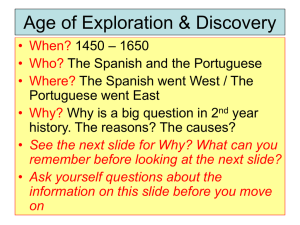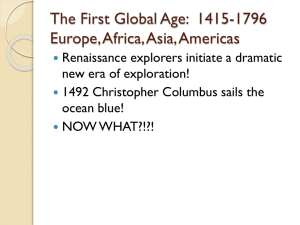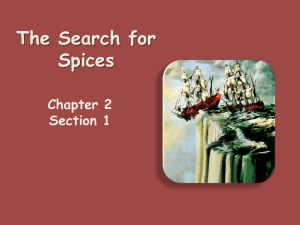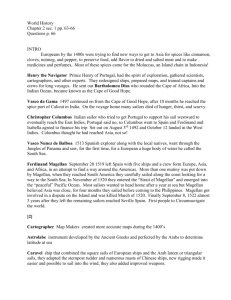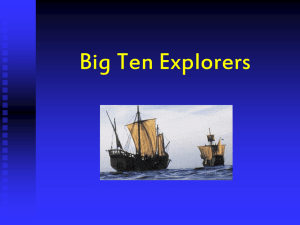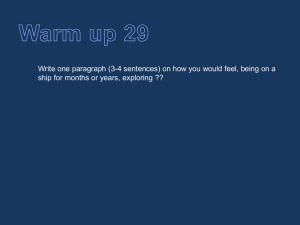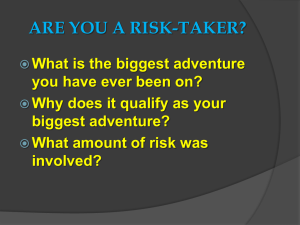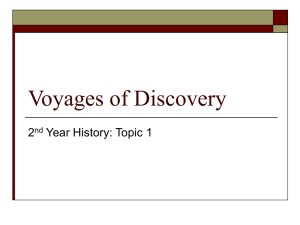Ferdinand Magellan (1480?-1521)
advertisement
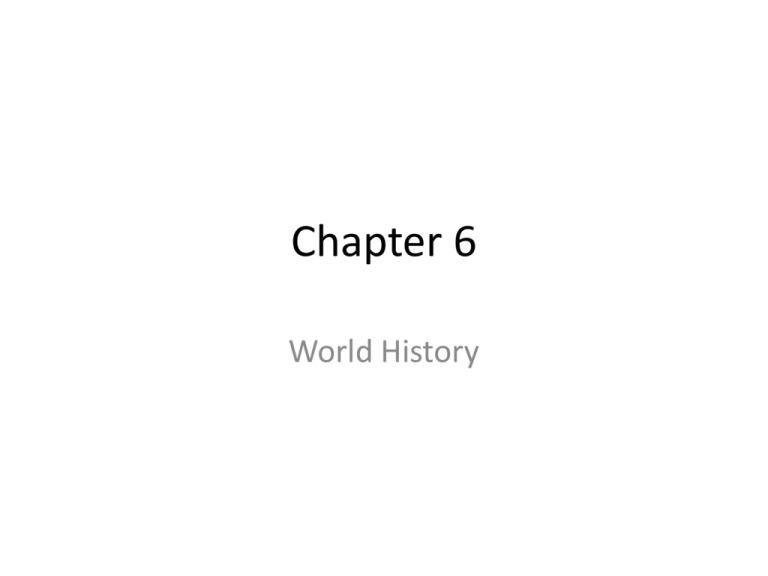
Chapter 6 World History 8 MOTIVES AND MEANS FOR EUROPEAN EXPLORATION 1. Europeans had been attracted to Asia. 2. Marco Polo had written accounts of the Far East. 3. Ottoman Turks reduced the ability of travel by land so Europeans wanted to gain access to Asia by sea. 4. Merchants wanted to expand trade. 5. They needed spices to preserve and flavor food. 6. The three chief motives were the three G’s: God, Glory, and Gold. 7. European monarchies increased their power and resources to make voyages possible. 8. Technology enabled European explorers to make a series of voyages beyond Europe. Prince Henry the Navigator (1394-1460) • Portuguese prince who sponsored early voyages of discovery along the west coast of Africa. • The son of King John I, he established a court at Sagres (1419) composed of cartographers, navigators, shipbuilders, and seamen. • Under his direction the Portuguese caravel was developed, mapmaking was refined, and other advances important to voyages of discovery were made. Prince Henry the Navigator (1394-1460) • • Though he never sailed himself, Henry organized the expeditions that rediscovered the Madeira Islands (1418), and by degrees ranged southward along, but never quite rounded, the Horn of Africa. In 1441 his ship came back laden with gold dust and slaves, thus providing the means for financing further expeditions. To oversee the burgeoning slave trade, Henry built the first European trading post overseas (1448), a fort on Arguin Island off the Horn of Africa. Later, his captains rounded Cape Verde (1444) and voyaged down the coast as far as present-day Sierra Leone (1460). The voyages to Africa sponsored by Henry began the age of discovery, and laid the foundation for the Portuguese colonial empire. Prince Henry the Navigator Bartholomeu Dias (1450?-1500) • The first European to see the stormy Cape of Good Hope at the southern tip of Africa. • He was one of the great Portuguese seamen who helped find the southeastern water route between Europe and Asia. Bartholomeu Dias Bartholomeu Dias (1450?-1500) • As a youth Diaz entered the hazardous gold and ivory trade along the African Gold Coast and rose to the rank of captain. At this time the Italian cities were growing rich on their trade with India and the Far East. Portugal and other European nations were eager for a share of this trade. However, the Italians controlled the Mediterranean, which was the chief trade route to the East. The Portuguese dreamed of finding an all-water route around Africa. The groundwork was laid by Prince Henry, who had sent ships on voyages down the African coast (see Henry the Navigator). Exploration continued under his nephew, King John II. When Diogo Cam (or Cao) returned to Portugal with word that he had sailed past the mouth of the Congo River, John planned to send another expedition to sail even closer to the southern end of the continent. He chose Diaz to lead the venture. With two caravels and a storeship Diaz left Lisbon in August 1487. He sailed straight from Cape Palmas to the mouth of the Congo, then kept close to the coast until he reached Cabo da Volta (present-day Luderitz). About New Year's Day 1488 a gale hit his ships and blew them southward, past the southernmost tip of land. After 13 days he managed to turn east, but found no sheltering shore. Turning north, he sighted Mossel Bay, beyond the Cape of Good Hope. Unknowingly and out of sight of land, he had rounded the cape. Almost at the entrance to the Indian Ocean, Diaz' crew, weary and afraid, virtually forced him to turn back. On the return voyage he charted the southern waters, and in May 1488 he saw the Cape of Good Hope for the first time (see Cape of Good Hope). Diaz called it Cabo Tormentoso-"stormy cape." Diaz was welcomed home in December 1488. The task that he began was completed ten years later by Vasco da Gama, who sailed around the Cape of Good Hope and on to India (see Gama). Diaz supervised the building of Da Gama's ships. In 1500 Diaz sailed as one of the captains in a large fleet headed by Pedro Alvares Cabral (see Cabral). Their destination was India, but they made a wide sweep into the South Atlantic and touched on the shores of Brazil. Then they headed southeastward and encountered fierce storms. Four ships went down, and all on board, including Diaz, were drowned. Vasco da Gama (1460-1524) • Portuguese navigator who first made the sea voyage from Europe to India. His voyage and the trade it opened up with India provided the foundation for the Portuguese Empire. Vasco da Gama Vasco da Gama (1460-1524) • • Chosen by King Manuel I to find a route to India, he sailed with four ships in 1497. He rounded the Cape of Good Hope (already explored by 1488) and after enduring both storms and mutinies he reached Calicut in India (1498). He subsequently commanded a fleet of 20 ships on a second voyage to India (1502-03). This time he founded the Mozambique and Sofala colonies on the African coast and, after leading a naval attack, established Portuguese rule over Calicut. Sent to India as a viceroy in 1524, he died soon after his arrival. Alfonso de Albuquerque (1453-1515) • • Portuguese viceroy of the Indies (1506-15), a principal founder of Portugal's empire in the East. As viceroy, he conquered Goa in India (1510) and made it a center of Portuguese power. He went on to conquer other eastern territories, including Ceylon and Melaka on the Malay Peninsula which was a thriving port for the spice trade. He twice took Ormuz (1507, 1515) to control the Arab spice trade. Alfonso de Albuquerque Melaka • • • • Thriving port for the spice trade on the Malay Peninsula. It was important to the Portuguese to destroy Arab control of the region and it was also used as a weigh station. Melaka is the capital of Melaka, a state of Malaysia. Melaka lies on the southwest coast of the Malay Peninsula, 125 miles (201 kilometers) northwest of Singapore. Melaka lies in an area that produces pepper, rice, and sage. In the 1400s, the city became the most important port in Southeast Asia. The Portuguese captured the city in 1511. The Dutch seized Melaka in 1641, and the British gained control of the city in 1824. Melaka is no longer a major Asian port. • The Spanish established an overseas empire that was quite different from the Portuguese trading posts. • The Spanish had greater resources and a higher population. Christopher Columbus (1451-1506) • Genoese navigator in the service of Spain, credited with the discovery of America in 1492. It was not until 1492, however, that the Spanish monarchs Ferdinand and Isabella agreed to support his venture. Christopher Columbus Christopher Columbus (1451-1506) • • He left Spain (August 3, 1492) with three ships, (the Santa Maria, Nina, and Pinta) and landed on the island of San Salvador in the Bahamas on October 12, 1492, just over two months later. Believing he had reached islands east of Japan, he briefly explored the Caribbean, including the coastline of Cuba and the island of Hispaniola, and then returned to Spain later in October. Christopher Columbus Christopher Columbus (1451-1506) • Three other voyages followed (1493, 1498, 1502), on which he discovered other Caribbean islands and reached the South American coast. Unable to adequately administer the Spanish colony in the New World he was removed as governor (1500), and died shortly after his disastrous fourth voyage (1502-04). o At dawn on Aug. 3, 1492, the three ships hoisted anchor in the Palos harbor and got under way. Only three days out of Palos, the Pinta lost its rudder and the Nina's lateen rig proved unsuitable. Columbus had planned to stop at the Canary Islands only long enough to load fresh provisions and water, but he extended his stay to install a new rudder on the Pinta and square rigging on the Nina. On September 9 the three ships left the Canaries and spread their sails. Steady trade winds from the northeast drove them on their course due west. As they sailed westward, Columbus kept two records of progress. One was the distance he thought they had actually traveled. The other was a much shorter estimate that he showed the crew to quiet their fears at being so far from home. The false record was nearer to the actual mileage than the secret one. Columbus' mistakes were common to the times. His navigation instruments were crude, and, like most captains, he had little practice in their use. For the most part the passage was smooth and the winds were steady. As the days passed, however, the men could not see how they could sail home against winds that had blown them steadily west. About midway in the voyage the seamen noted that the compass varied to the west of true north. They were familiar with the easterly variation in the Mediterranean, but this change was new and fearful (see Compass, Magnetic). A falling meteor and the thick-growing plants of the Sargasso Sea increased their fears. On October 8 and 9 the men were ready to rebel. Columbus had to agree to turn back if land was not sighted within three days. On October 11 the Pinta fished up a piece of bamboo, a pole, a board, and a stick that seemed to have been shaped by tools. At 10 PM Columbus himself thought he saw lights. At 2 AM on October 12, Rodrigo de Triana, a seaman aboard the Pinta, cried loudly the first sight of the New World. The voyage from the Canaries had taken 33 days. o The little Spanish fleet had sailed among the Bahama Islands. Columbus named the first land sighted San Salvador (probably now Watling Island). Its Indian name was Guanahani. The ships' boats were put over the side and Columbus, accompanied by officers and crewmen, landed. With them they carried the royal banners of Ferdinand and Isabella. They were met by a band of curious but peaceful natives. The Spaniards knelt on the sand and gave thanks to God for the safe and successful voyage. Then, while the natives watched, Columbus took possession of the island in the name of the rulers of Spain. The crewmen, delighted with the rich and unexpected discovery of this island, begged Columbus' forgiveness for their disobedience. The natives were friendly and helpful. Columbus, believing San Salvador to be an island of the Indies, called them Indians. At once the men began trading with the Indians, offering hawks' bells and glass beads for the Indians' ornaments. Sailing on, Columbus stopped at islands he named Santa Maria de la Concepcion (now Rum Cay), Fernandina (Long Island), and Isabela (Crooked Island). He then sailed south to the north coast of Cuba. He named this island Juana. Everywhere he asked the Indians where gold could be found. On Dec. 6, 1492, he reached the north coast of Hispaniola. Previously he had found small trinkets of gold, but here the natives told of a gold mine in the interior of the island. Early Christmas morning the Santa Maria went aground off Cap Haitien. Before it could be worked off, its bottom was so badly torn that the ship had to be abandoned. From its timber Columbus built a small fort, La Navidad. The sailors, excited by stories of gold, begged to be left as colonists. Columbus selected 39 to stay. Line of Demarcation • This line extended from north to south through the Atlantic Ocean and the easternmost part of the South American continent. Unexplored territories east of the line would be controlled by Portugal, and those west of the line by Spain. This was according to the Treaty of Tordesillas. Line of Demarcation • • Line of Demarcation was an imaginary line drawn by Pope Alexander VI to settle land claims. The line was drawn in 1493, after Christopher Columbus returned from his first voyage to the Americas. The pope hoped it would prevent disputes between Spain and Portugal over new lands discovered by Spanish and Portuguese explorers. The line ran from north to south about 350 miles (563 kilometers) west of the Azores and Cape Verde Islands. It barely touched the east coast of the South American mainland, which had not yet been discovered by Europeans. Spain was permitted to claim land to the west of the line, and Portugal could claim land to the east of the line. Neither nation found this settlement satisfactory. So the next year Spain and Portugal moved the line west to a point about 1,295 miles (2,084 kilometers) west of the Cape Verde Islands, by the Treaty of Tordesillas. This agreement later supported Portugal's claim to territory that is now eastern Brazil. The line was never surveyed, so its exact location was not determined. Scholars think that it lay near the 48° west longitude line. A continuation of the Line of Demarcation around the globe and into the Eastern Hemisphere gave Portugal the right to claim the Philippine Islands. Spain recognized this claim in the Treaty of Saragossa in 1529, which set the line 17° east of the Moluccas (Spice Islands). In later treaties with Spain, Portugal gave up its claim to the Philippines and won the rest of Brazil. But Portugal and Spain could not secure all the newly discovered lands, because France, England, and the Netherlands ignored the Line of Demarcation and claimed territory for themselves. John Cabot (1450-1498) • • Italian navigator serving England. On a voyage of discovery (1497), he landed at what may have been Cape Breton Island and explored the coastline of Nova Scotia and Newfoundland. Voyages of John Cabot John Cabot Amerigo Vespucci (1454-1512) • • • • Italian navigator who explored some 6,000 miles of the east coast of South America, including the mouths of the Amazon River (1499) and the Rio del la Plata (1500). Vespucci realized the New World was a new continent, instead of a part of Asia as had been thought. The name "America" is derived from his name. Vespucci also devised a method for figuring longitude with remarkable accuracy and calculated the earth's circumference to within 50 miles of its true measure. Amerigo Vespucci Conquistadors • Spanish military adventurers who led the Spanish exploration and conquest of the New World. Hernan Cortés (1485-1547) • • Spanish conquistador who conquered Mexico and the Aztec Empire (1519-1521). Spanish conquistador and conqueror of Mexico (1519-21). He joined with D. Velazquez in conquering Cuba (1511), then led a military expedition into Mexico to conquer the Aztec empire of Montezuma for Spain. Setting out (1519) with 600 men and 16 horses, and ignoring Velazquez's orders that he return, he burned his eleven ships on arriving in Mexico, to prevent his men from retreating. Hernan Cortés Hernan Cortés (1485-1547) • After conquering Mayan tribes, he marched to the Aztec capital of Tenochtitlan (later Mexico City). Montezuma received Cortes, believing him to be the descendant of an Aztec god; Cortes immediately took him hostage. After traveling to the coast to defeat forces sent by Velazquez, Cortes returned to the capital to find the Aztecs in revolt. In a famous battle known as La Noche Triste ("The Sad Night," 1520), Cortes suffered heavy casualties. Returning a year later, he conquered the city and, with it, the empire. He was, however, replaced (1526) as governor of New Spain. He died (1547) in Spain, disillusioned and embittered. Hernan Cortés Francisco Pizarro (1476-1541) • • Francisco Pizarro Spanish conquistador who conquered the Inca Empire in Peru (1531-1533). He first went to the New World in 1509, and accompanied Vasco Nunez de Balboa when the latter sighted the Pacific Ocean (1513). With Diego de Almagro, he explored (152226) the west coast of South America, then returned to Spain (1528) to prepare for the conquest of Peru. Francisco Pizarro (1476-1541) • In 1531, with fewer than 200 men, he enticed the Inca chieftain Atahualpa into his hands by treachery, extracted an enormous ransom from him, and later had him executed (1533). He then captured the city of Cuzco, and the conquest of Peru was completed. Pizarro founded Lima (1535). In 1537-38, he came into conflict with Almagro and his followers, and he ordered Almagro beheaded. Pizarro was later assassinated by Almagro's followers (1541). Francisco Pizarro • • • Encomienda System for supplying Indian laborers in Spanish colonial America (16th-18th centuries). The encomienda (entrustment) specified that a Spanish settler would receive a certain number of Indian laborers, in return for which he would protect them and instruct them in Christianity. The system resulted in great hardships for the Indians despite attempts at reform (16th century). Forced labor through the encomienda system, starvation, and especially disease took a toll on Native American lives. 80% of Native Americans died due to the arrival of Europeans. Columbian Exchange • The transatlantic trade of crops, technology, and culture between the Americas and Europe, Africa, and Asia that began in 1492 with Columbus’s voyage. More Information on Columbian Exchange Ferdinand Magellan (1480?-1521) • He led the first expedition that sailed around the world, though he died in route. • The first European to sail across the Pacific Ocean and the first to discover a route by which ships could sail a complete circle around the world, Ferdinand Magellan was the Portuguese navigator for whom the Strait of Magellan is named. Ferdinand Magellan Ferdinand Magellan (1480?-1521) • The strait, located at the southern tip of South America, proved to be the long-sought connection between the Atlantic and Pacific oceans. Sailing for the Spanish king Charles I (later Holy Roman Emperor Charles V), Magellan showed in his explorations that the Earth is round. He also established a new route to the riches of the East, a route that involved sailing to the west. Ferdinand Magellan (1480?-1521) • • • Fernao de Magalhaes was born in about 1480, probably in Oporto, Portugal. (Ferdinand Magellan is the English spelling of his name.) The son of a Portuguese nobleman, he served with distinction in the Indies and Morocco during his youth. He felt that he was not sufficiently rewarded for these services, and the Portuguese king advised him to offer his services elsewhere. He therefore gave up his nationality and offered his services to the ruler of Spain in 1517. The Portuguese claimed that all the islands of the Far East lay in the portion of the Earth assigned to Portugal by Pope Alexander VI (see America, Discovery and Colonization of). Magellan claimed that many of them, including the rich Spice Islands, or Moluccas, actually lay in Spain's territory. He said that the Portuguese maps had been falsified to conceal this fact. Magellan offered to use his knowledge of Portuguese secrets to prove his claim. He planned to reach the Spice Islands by sailing westward through a strait that he hoped to discover at the southern tip of America. The Spanish king finally accepted Magellan's proposal. On Aug. 10, 1519, Magellan set sail from Seville in command of five small vessels. He sailed across the Atlantic Ocean and down the coast of South America until cold weather and winter storms forced him to seek winter quarters. A mutiny was put down by force. Ferdinand Magellan (1480?-1521) • • • • Sailing again in September of 1520 (spring in the Southern Hemisphere), Magellan's fleet rounded a promontory, and on October 21 he sighted what he guessed to be the sought-for strait. Two ships went ahead and reported that the strait led to an ocean beyond. The fleet proceeded. What they had thought to be the ocean, however, proved to be only a large bay in the strait. At a council with his navigators Magellan decided to go on. For more than a month he battled his way through the stormy 360-mile (580-kilometer) passage that now bears his name. One vessel was wrecked, and another sailed back to Spain. Nevertheless, Magellan insisted on going ahead. On November 28 he reached the ocean that Balboa had discovered seven years before. Because the ocean now looked so calm, Magellan named it the Pacific. At first the voyage on the Pacific went well. After a month of sailing, however, terrible hardships struck the fleet. The food ran low, and the sailors were reduced to eating the leather fittings of the ship. There was a scarcity of drinking water, and many of the crew died of scurvy. The fleet sailed about 100 days before arriving at the islands that are now called the Philippines. At Massava Magellan negotiated Spain's first alliance in the Pacific. At Cebu he converted the king and his chief followers to Christianity. Magellan sailed from Cebu to the neighboring island of Mactan. There he and his men became involved in a fight with the natives, and Magellan was killed on April 27, 1521. Under the leadership of Juan Sebastian del Cano, the sailors burned one of the three remaining vessels and sailed to the Spice Islands. Another ship started to leak and had to be abandoned. The last remaining vessel, the Victoria, commanded by Del Cano, set out for home. Leaky but laden with spices, the Victoria rounded the Cape of Good Hope and dropped anchor in the harbor of Seville on Sept. 9, 1522. After a voyage of slightly more than three years, it had circled the globe. Contrary to popular belief, Magellan succeeded in sailing around the world before his death. He did not encompass the globe on a single voyage, however. On a previous eastbound voyage to the East Indies, he had gone beyond the longitude of the Philippines. Thus, at the time he was killed, he had already overlapped his earlier course. In the history of discovery no name ranks higher than that of Magellan. He opened the Pacific Ocean to new exploration and trade. John Fiske, the American historian, says: "The voyage thus ended was doubtless the greatest feat of navigation that has ever been performed, and nothing can be imagined that would surpass it except a journey to some other planet." Ferdinand Magellan (1480?-1521) • By the end of the 16th century new European rivals had entered the scene for eastern trade. The Spanish established themselves in the Philippine Islands. At the start of the 17th century England had established trade India and Southeast Asia. The Dutch created the East India Company to compete with England and Portugal. The Dutch also created the West India Company to compete with Spain and Portugal in the Americas. • After 1660, however, rivalry with Britain and France brought and end to the Dutch commercial empire in the Americas. By the 1700’s the British had colonized the eastern seaboard of North America and had set up sugar plantations in the various islands of the Caribbean. The French controlled parts of Canada and Louisiana. Colony • A settlement of people living in a new territory, linked with the parent country by trade and direct government control. Mercantilism • A set of economic principles that dominated economic thought in the 1600’s. • According to mercantilism the prosperity of a nation depended on a large supply of bullion. Bullion • A bulk quantity of precious metal, usually gold or silver, that is usually in bars. Balance of Trade •The difference in value between what a nation imports and what it exports over time. • Cane sugar was introduced to Europe from Southwest Asia during the Middle Ages. During the 16th century large agricultural estates were set up along the coast of Brazil and on islands in the Caribbean to grow sugarcane. • Growing sugar cane demands much labor. The small Native American population, much of which had died from diseases imported from Europe, could not provide the labor needed. Thus, African slaves were shipped to Brazil and the Caribbean to work on the plantations. Triangular Trade •A pattern of trade that connected Europe, Africa and Asia, and the American continents. Triangular Trade •A pattern of trade that connected Europe, Africa and Asia, and the American continents. More Information on Triangular Trade Middle Passage • The middle portion of the triangular trade • • • • route. The first shipment of slaves to the Americas was made by Portugal. Approximately 10 million slaves were brought to the Americas. So many slaves were brought to the Americas because of the high death rate. Most of the first slaves were prisoners of war. Citations 1. 2. 3. 4. 5. 6. 7. 8. 9. 10. 11. 12. 13. 14. 15. 16. 17. 18. "Biography of Bartolomeu Dias." Biography of Bartolomeu Dias Hisotory Awake's Once Again . Web. 25 Jan 2011. <http://historyawakes.wordpress.com/biographyof-bartolomeu-dias/>. "prince_henry.jpg." prince_henry.jpg. Web. 25 Jan 2011. <http://www.zunal.com/myaccount/uploads/prince_henry.jpg>. "Vasco-da-Gama-Shaw.jpg." Vasco-da-Gama-Shaw.jpg. Web. 25 Jan 2011. <http://upload.wikimedia.org/wikipedia/commons/f/f9/Vasco-da-Gama-Shaw.jpg>. "Vasco-da-Gama-Shaw.jpg." Vasco-da-Gama-Shaw.jpg. Web. 25 Jan 2011. http://upload.wikimedia.org/wikipedia/commons/f/f9/Vasco-da-Gama-Shaw.jpg. Afonso_de_Albuquerque. Web. 25 Jan 2011. <http://upload.wikimedia.org/wikipedia/commons/3/32/Afonso_de_Albuquerque_transparent_BG.png>. "Christopher Columbus." Goggle Images. Web. 25 Jan 2011. <http://www.google.com/imgres?imgurl=http://www.comicbookreligion.com/img/c/h/Christopher_Columbus.jpg&imgrefurl=http://www.comicbookreligion.com/ %3FNation%3DSpain&usg=__cQKJ8XyYz-WTSpkksVWgrYRy68Y=&h=385&w=393&sz=47&hl=en&start=23&zoom=1&tbnid=Jrk9VCBcexBXM:&tbnh=147&tbnw=150&ei=zc_TdLmFsSblgfQ2qnoAg&prev=/images%3Fq%3Dchristopher%2Bcolumbus%26hl%3Den%26safe%3Dactive%26biw%3D1152%26bih%3D745%26gbv%3D2%26tbs %3Disch:10,600&itbs=1&iact=hc&vpx=709&vpy=275&dur=60&hovh=222&hovw=227&tx=122&ty=133&oei=8Dc_TdjFIMOBlAeMoOT5Ag&esq=2&page=2&ndsp=2 6&ved=1t:429,r:10,s:23&biw=1152&bih=745>. "Treaty of Tordesillas." World News. Web. 26 Jan 2011. <http://wn.com/Treaty_of_Tordesillas>. "cabot.jpg." People.bu.edu (Boston University). Web. 26 Jan 2011. <http://people.bu.edu/wwildman/ben/mass/images/cabot.jpg>. "1498." people.bu.edu. Boston University, n.d. Web. 26 Jan 2011. http://people.bu.edu/wwildman/ben/mass/1498.htm. "Amerigo Vespucci." vespucci.GIF. Web. 26 Jan 2011. <http://library.thinkquest.org/4034/Media/vespucci.GIF>. "Spanish Conquistadors." conquistadors.jpg. Web. 26 Jan 2011. <http://www.blackstudies.ucsb.edu/antillians/images/conquistadors.jpg>. "Conquistadors." conquistadors.jpg. Web. 26 Jan 2011. <http://www.marcnorton.us/mediac/400_0/media/DIR_85722/conquistadors.jpg>. "Hernan Cortes." cortes_hernan.jp. Web. 26 Jan 2011. <http://www.bbc.co.uk/history/historic_figures/images/cortes_hernan.jpg>. "Francisco Pizarro." francisco-pizarro-2.jpg. Web. 27 Jan 2011. <https://jspivey.wikispaces.com/file/view/%EC%9A%94%EA%B1%B0francisco-pizarro2.jpg/71426081/%EC%9A%94%EA%B1%B0francisco-pizarro-2.jpg>. Crouthamel, Steven, J. "Columbian Exchanges."http://daphne.palomar.edu. Palomar College, n.d. Web. 27 Jan 2011. <http://daphne.palomar.edu/scrout/colexc.htm>. "Ferdinand Magellan." 225px-Magellan_1810_eng. Web. 27 Jan 2011. <http://upload.wikimedia.org/wikipedia/commons/thumb/c/c3/Magellan_1810_engraving.jpg/225px-Magellan_1810_engraving.jpg>. "Ferdinand Magellan Route."_42345158_voyage_vicotia. Web. 27 Jan 2011. <http://newsimg.bbc.co.uk/media/images/42345000/gif/_42345158_voyage_victoria_map416.gif>. "Triangular Trade Routes." Interactive Map: Triangular Trade. Web. 27 Jan 2011. <http://www.eduplace.com/kids/socsci/books/applications/imaps/maps/g5s_u3/index.html>.
